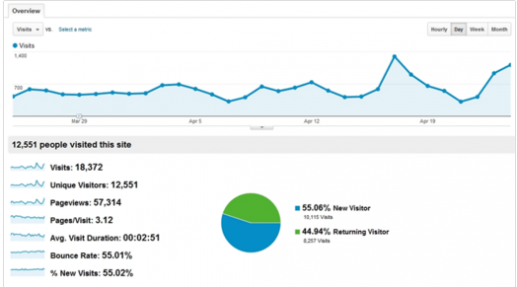If you have been reading us for long enough you know that we are big fans of data driven decision making.
9 times out of 10, making decisions backed by hard data is the smart thing to do.
For most traditional companies though, a lot of data which offers deep insights into how their product is being used is very hard to come by. And therefore, a lot of decisions around product improvement or customer engagement are driven by some sort of guesstimate.
Seen from this perspective, SaaS companies have it easy.
Because their product lives on the internet it is trivial for them to find out which sources are driving the highest amount of traffic, which features are the most used, or which customers are the least engaged with the product.
Vanity and actionable metrics
SaaS companies have a different problem, the problem of plenty.
They suffer from channel fatigue, and from data overwhelm. With the never ending stream of data hitting them 24x7x365 they are struck by analysis paralysis, delaying decisions as they try to make sense of all that data…
…or even worse, make decisions based on the wrong set of data.
This is why many companies invest in increasing the number of likes or followers on social media over number of email subscribers, or drive traffic to their site instead of improving conversion rates.
Companies fall prey to vanity metrics which make them look good but has negligible actionable insights that can grow their business.
Vanity metrics are the numbers you want to publish on TechCrunch to make your competitors feel bad- Eric Reis, author of “The Lean Startup”
Want to know what vanity metrics look like? Log into Google Analytics and go to Visitor Overview
This graph might give you a dopamine high but all those metrics are vanity metrics, and they tell you nothing about the health of your business.
There’s no way to tell why all that traffic came to your site. Pageviews can increase if the site is hard to navigate. And this graph tells you nothing about whether all those visitors actually amounted to anything other than grabbing up bandwidth.
Want another example?
Email open rates.
That number tells you nothing about the impact of the email marketing campaign. All it signifies is that your emails were delivered correctly and the subject line was interesting enough to be opened.
What you want to start with is by concentrating on actionable metrics. They actually offer insight into how well your business is doing, and they will help you make more informed decisions.
Some of the actionable metrics you want to track are:
- Goal Completion Rate,
- Conversion Rate of landing pages,
- Revenue (Annual Recurring Revenue, Monthly Recurring Revenue, or Average Revenue Per User),
- Customer Acquisition Cost, and
- Life Time Value.
But don’t stop here. If you want to really beat your competition you will have to pick one metric which signifies that the user is actually getting value from the product, and focus obsessively on hitting it.
In the SaaS world this is called the North Star metric.
The importance of North Star metric
The definition of North Star metric is simple: the one metric which has the most impact on growth. This metric is obviously unique to each company.
This in-depth video gives details of what exactly is a North Star metric.
On the path to 1 billion users Facebook did nothing but concentrated increasing the number of monthly active users.
Whatsapp’s North Metric was the number of Sent messages.
For Airbnb, number of nights booked is the North Star Metric.
eBay’s North Star metric is the Gross Merchandise Volume.
For Square, the North Star metric is the number of transactions.
According to Alex Schultz, VP of Growth at Facebook, this is how you arrive at your North Star metric
What’s the one metric that everyone in the company needs to base their actions off? Their actions should correlate with moving that metric up.
Pick the one that you feel the deepest about. It should align with your metrics and your values.
You must be able to stick with it for a long time.
The magical moment (the point where users actually get the value of your product) must be correlated with your north star. If your users can get to that magical moment, it should help drive your north star.
Conclusion
The beauty of North Star metric is that it makes decision making simple.
Because the North Star metric is an global metric instead of a marketing or a sales metric it can be used by anyone regardless of whether they are building the user interface for the mobile app, designing an email marketing template, or setting up a referral program.
Get your North Star metric, cut through the fog and the noise, and start growing exponentially.











